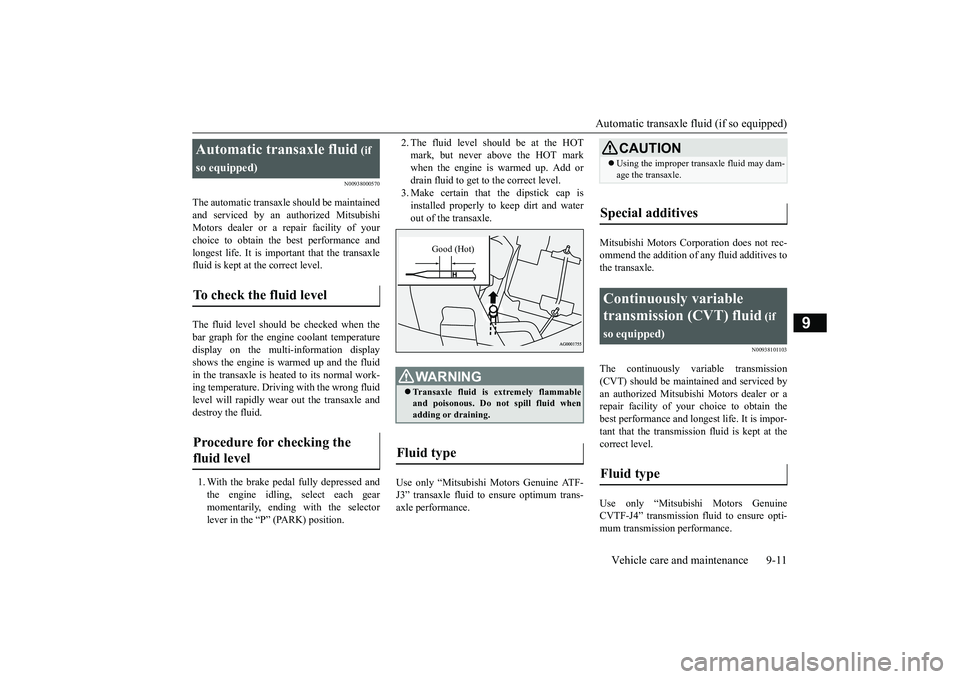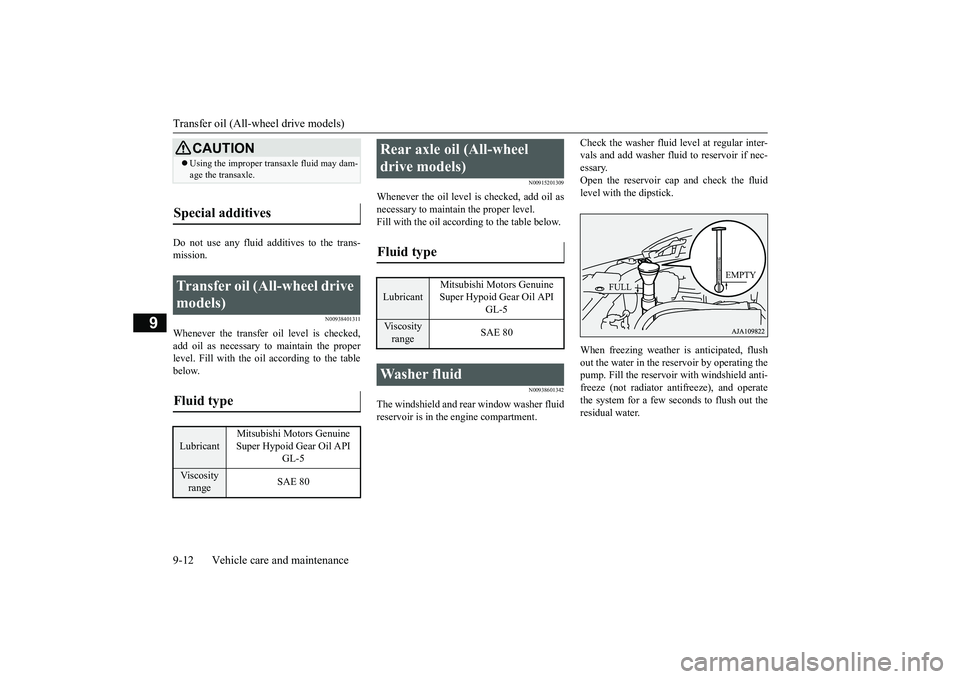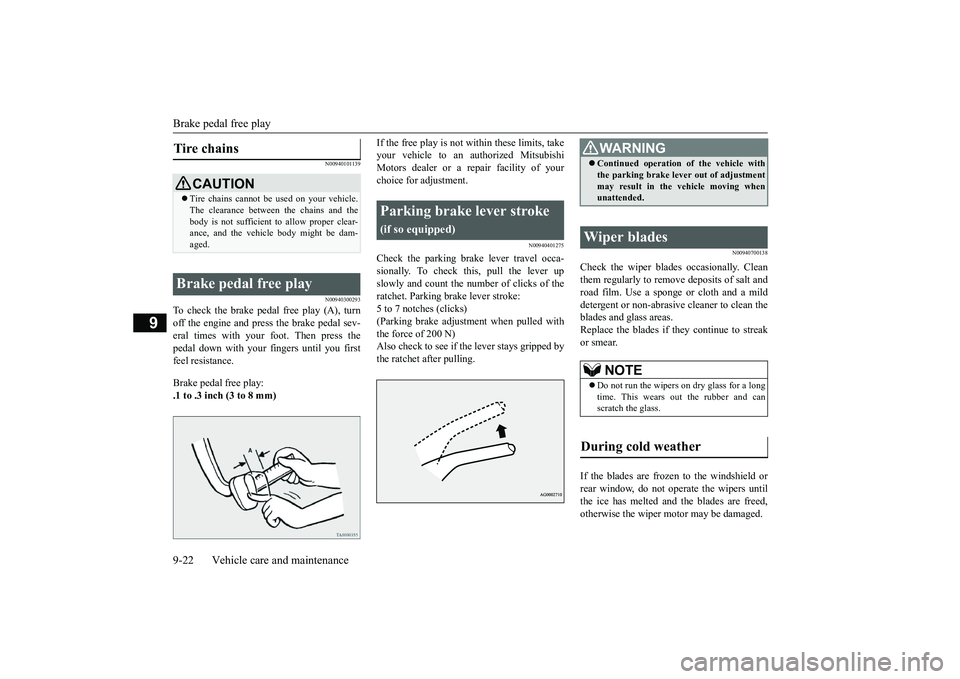2018 MITSUBISHI OUTLANDER III engine
[x] Cancel search: enginePage 386 of 441

Air cleaner filter
Vehicle care and maintenance 9-9
9
The radiator cap must be sealed tight to pre-vent losing coolant, which may result inengine damage. Only use a MitsubishiMotors Genuine Parts radiator cap, or anapproved equivalent.
Do not overfill the reserve tank.Your vehicle uses a
special radiator cap
that stays sealed and lets the coolant flowfrom the reserve tank back to the radiatorwhen the engine cools down. If you needto change the cap, use the exact samekind.Check the coolant freeze point in the radi-ator with the proper gauge, and only whenit is safe. If you add antifreeze, the con-tents of the reserve ta
nk must be protected
against freezing.Keep the front of the radiator and con-denser clean.If the engine coolan
t temperature does not
rise after the engine
is warmed-up, take
your vehicle to an au
thorized Mitsubishi
Motors dealer or a repair facility of yourchoice to have the thermostat checked,and replaced if necessary.
N00937901494
The air cleaner filter w
ill get dirty and dusty
from use and not filter
properly. Replace it
with a new filter using the schedule in the“WARRANTY AND MAINTENANCEMANUAL”.1. For 2.4 L models, remove the two clips(A), then remove the Air duct (B).2. For 2.4 L models,
while holding down the
tab (C), pull out the connector (D).
The required concentration of anti-freeze dif-fers depending on the
expected ambient tem-
perature.Above -31 °F (-35 °C):of anti-freezeBelow -31
Page 387 of 441

Air cleaner filter9-10 Vehicle care and maintenance
9
3. Unclamp the cover. Open up the top of thecover and take out th
e air cleaner filter.
4. Replace the air cleane
r filter and put the
cover back on in its original position.
5. For 2.4 L models, put the duct back on inits original position.
2.4 L models
NOTE
Mitsubishi Motors Genuine Parts are recom-mended when replacing th
e air cleaner filter.
For 2.4 L models, make
sure that the connec-
tor is properly reconnected.After replacing the air cleaner filter, makesure that the hinges at the bottom of coverare firmly set.3.0 L models
CAUTIONTake care not to scra
tch the engine air flow
sensor when removing
the air cleaner cover.
2.4 L models3.0 L models
BK0249100US.book 10 ページ 2017年5月10日 水曜日 午前8時49分
Page 388 of 441

Automatic transaxle fluid (if so equipped)
Vehicle care and maintenance 9-11
9
N00938000570
The automatic transaxl
e should be maintained
and serviced by an authorized MitsubishiMotors dealer or a repair facility of yourchoice to obtain the
best performance and
longest life. It is impor
tant that the transaxle
fluid is kept at the correct level.The fluid level should be checked when thebar graph for the engine coolant temperaturedisplay on the multi-information displayshows the engine is warmed up and the fluidin the transaxle is heated to its normal work-ing temperature. Driving with the wrong fluidlevel will rapidly wear
out the transaxle and
destroy the fluid.1. With the brake pedal fully depressed andthe engine idling,
select each gear
momentarily, ending with the selectorlever in the “P” (PARK) position.
2. The fluid level should be at the HOTmark, but never above the HOT markwhen the engine is warmed up. Add ordrain fluid to get to the correct level.3. Make certain that the dipstick cap isinstalled properly to keep dirt and waterout of the transaxle.
Use only “Mitsubishi Motors Genuine ATF-J3” transaxle fluid to
ensure optimum trans-
axle performance.
Mitsubishi Motors Corp
oration does not rec-
ommend the addition of
any fluid additives to
the transaxle.
N00938101103
The continuously variable transmission(CVT) should be maintained and serviced byan authorized Mitsubishi Motors dealer or arepair facility of your
choice to obtain the
best performance and longe
st life. It is impor-
tant that the transmission fluid is kept at thecorrect level.Use only “Mitsubish
i Motors Genuine
CVTF-J4” transmission fluid to ensure opti-mum transmission performance.
Automatic transaxle fluid
(if
so equipped)To check the fluid level
Procedure for checking the fluid level
WA R N I N GTransaxle fluid is extremely flammableand poisonous. Do not spill fluid whenadding or draining.
Fluid type
Good (Hot)
CAUTIONUsing the improper transaxle fluid may dam-age the transaxle.
Special additives
Continuously variable transmission (CVT) fluid
(if
so equipped)Fluid type
BK0249100US.book 11 ページ 2017年5月10日 水曜日 午前8時49分
Page 389 of 441

Transfer oil (All-w
heel drive models)
9-12 Vehicle care and maintenance
9
Do not use any fluid additives to the trans-mission.
N00938401311
Whenever the transfer oil level is checked,add oil as necessary to maintain the properlevel. Fill with the oil according to the tablebelow.
N00915201309
Whenever the oil level is checked, add oil asnecessary to maintain the proper level.Fill with the oil according to the table below.
N00938601342
The windshield and rear window washer fluidreservoir is in the
engine compartment.
Check the washer fluid
level at regular inter-
vals and add washer fluid to reservoir if nec-essary.Open the reservoir cap and check the fluidlevel with the dipstick.When freezing weather is anticipated, flushout the water in the reservoir by operating thepump. Fill the reservoi
r with windshield anti-
freeze (not radiator an
tifreeze), and operate
the system for a few seconds to flush out theresidual water.
CAUTIONUsing the improper transaxle fluid may dam-age the transaxle.
Special additives
Transfer oil (All-wheel drive models) Fluid type Lubricant
Mitsubishi Motors Genuine Super Hypoid Gear Oil API
GL-5
Viscosity range
SAE 80
Rear axle oil (All-wheel drive models) Fluid type Lubricant
Mitsubishi Motors Genuine Super Hypoid Gear Oil API
GL-5
Viscosity range
SAE 80
Washer fluid
FULL
EMPTY
BK0249100US.book 12 ページ 2017年5月10日 水曜日 午前8時49分
Page 391 of 441

Battery9-14 Vehicle care and maintenance
9
Do not fill above the t
op line because a spill
during driving could cause damage.The battery is weaker in cold temperatures.This has to do with its chemical and physicalproperties and is why a very cold battery,especially one with a low charge, will have ahard time starting your vehicle.It is recommended that you have your batteryand charging system checked by an autho-rized Mitsubishi Motors dealer or a repairfacility of your choice before the start of coldweather. If necessary, have it charged. Thiswill provide more relia
ble starting, and longer
battery life.To disconnect the battery cable, stop theengine. Disconnect the
negative (-) terminal
first, then the positive (+) terminal. To recon-nect the battery, first
connect the positive (+)
terminal and then the negative (-) terminal,before starting the vehicle.During cold weather Disconnection and connection
NOTE
Open the terminal cover (A) before discon-necting or connecting
the positive (+) termi-
nal of the battery.
Loosen the nut (B) and then disconnect thebattery cable from the positive (+) terminal.WA R N I N GNever disconnect the battery while theengine is running, or you could damagethe vehicle’s electrical parts.Never short-circuit the battery. This couldcause it to overheat and be damaged.Keep sparks, cigarettes, and flames awayfrom the battery because the battery couldexplode.Electrolyte (battery acid) is made of corro-sive diluted sulfuric acid. If it spills onnearby parts, it can crack, stain, or dis-color them. And if it gets on your skin orin your eyes, it can cause burns or blind-ness. Please observe the following han-dling instructions:NOTE
• If electrolyte gets on plastic parts orother nearby parts, wipe it off with a softcloth or chamois soak
ed in a solution of
water and neutral detergent then imme-diately rinse the affected parts withplenty of water.• If electrolyte gets on your hands orclothes, rinse thoroughly with water. Ifelectrolyte gets in
your eyes, flush them
with water immediately and get immedi-ate medical attention.
Open doors and wind
ows in any closed
space where you may be charging orworking with the battery.Always wear protective clothing and gog-gles when working with the battery, orhave a skilled automobile technician do it.If you are quick-ch
arging your battery,
first disconnect the battery cables.In order to prevent a
short-circuit, be sure
to disconnect the negative (-) terminalfirst, and reconnect it last.If the electrolyte level
is very low, have the
battery checked at an
authorized Mitsubi-
shi Motors dealer or
a repair facility of
your choice.Battery posts, terminals and related acces-sories contain lead
and lead compounds.
Wash hands after handling.WA R N I N G
BK0249100US.book 14 ページ 2017年5月10日 水曜日 午前8時49分
Page 399 of 441

Brake pedal free play9-22 Vehicle care and maintenance
9
N00940101139N00940300293
To check the brake pedal free play (A), turnoff the engine and press the brake pedal sev-eral times with your foot. Then press thepedal down with your fi
ngers until you first
feel resistance.Brake pedal free play:.1 to .3 inch (3 to 8 mm)
If the free play is not within these limits, takeyour vehicle to an
authorized Mitsubishi
Motors dealer or a repair facility of yourchoice for adjustment.
N00940401275
Check the parking brake lever travel occa-sionally. To check this, pull the lever upslowly and count the number of clicks of theratchet. Parking br
ake lever stroke:
5 to 7 notches (clicks)(Parking brake adjustment when pulled withthe force of 200 N)Also check to see if the lever stays gripped bythe ratchet after pulling.
N00940700138
Check the wiper blades occasionally. Cleanthem regularly to remove
deposits of salt and
road film. Use a sponge or cloth and a milddetergent or non-abrasive
cleaner to clean the
blades and glass areas.Replace the blades if th
ey continue to streak
or smear.If the blades are frozen to the windshield orrear window, do not operate the wipers untilthe ice has melted and the blades are freed,otherwise the wiper mo
tor may be damaged.
Tire chains
CAUTIONTire chains cannot be used on your vehicle.The clearance between
the chains and the
body is not sufficient to allow proper clear-ance, and the vehicle body might be dam-aged.
Brake pedal free play
Parking brake lever stroke
(if so equipped)
WA R N I N GContinued operation
of the vehicle with
the parking brake leve
r out of adjustment
may result in the
vehicle moving when
unattended.
Wiper blades
NOTE
Do not run the wipers on dry glass for a longtime. This wears out
the rubber and can
scratch the glass.
During cold weather
BK0249100US.book 22 ページ 2017年5月10日 水曜日 午前8時49分
Page 400 of 441

Emission-control system maintenanceVehicle care and maintenance 9-23
9
N00940800328
Your vehicle is equi
pped with an emission-
control system that meets all the requirementsof the U.S. Environm
ental Protection Agency
and Environment Cana
da. The emission-con-
trol system is made of:a positive crankcase
ventilation system
an evaporative emis
sion-control system
an exhaust emission-control system
To be sure the emissi
on-control system works
properly, have your vehicle inspected andmaintained by an authorized MitsubishiMotors dealer or a repair facility of yourchoice. This should be done at the time ormileage specified in the “WARRANTY ANDMAINTENANCE MANUAL”.These, and all the other “general” mainte-nance services listed in this manual, need tobe performed to keep
your vehicle running
properly and reliably.You should also have an inspection and ser-vice any time you suspect a malfunction.
N00940900231
Spark plugs must fire properly to ensureproper engine perfo
rmance and emission-
control.Do not reuse spark plugs by cleaning orregapping. Spark plugs should be replaced atthe mileage specified in the “WARRANTYAND MAINTENANCE MANUAL”.
Check the hose surfaces for any heat andmechanical damage, hard and brittle rubber,cracking, tears, cuts and abrasions. Pay spe-cial attention to the hos
es closest to high heat
sources such as the exhaust manifold. Checkall the hose connections
, such as clamps and
couplings, to make sure
they are secure and
that there are no leaks. If you see any wear ordamage, replace the
hoses immediately.
N00950100050
Have the valve clea
rance checked at an
authorized Mitsubishi Motors dealer at themileage specified in the “WARRANTY ANDMAINTENANCE MANUAL”.If the engine sounds abnormally loud, haveadjustments made by an authorizedMitsubishi Motors dealer.
N00941300173
Check these regularly for damage or leaks inthe fuel lines and connections. Check the fueltank filler cap for dama
ge or looseness. Pay
special attention to the fuel lines closest to
Emission-control system maintenance
NOTE
To meet government regulations and pro-mote cleaner air, your
vehicle is equipped
with an onboard dia
gnostic system (OBD).
The engine electronic control module thatcontrols OBD functions stores various data(especially a
bout the exhaust emissions).
This data will be erased if the battery cable isdisconnected, which c
ould make a rapid
diagnosis difficult.
Do not disconnect the
battery cable when the engine malfunctionindicator (“SERVICE ENGINE SOON” or“Check engine
light”) is ON.
Spark plugs
NOTE
Use the recommended or equivalent sparkplugs listed under “Engin
e specifications” on
page 11-6. Use of other plugs could causeengine damage, loss of performance or radionoise.
Fuel hoses Intake valve clearance Fuel system (tank, pipe line and connection, and fuel tank filler cap)
BK0249100US.book 23 ページ 2017年5月10日 水曜日 午前8時49分
Page 401 of 441

General maintenance9-24 Vehicle care and maintenance
9
high heat sources such
as the exhaust mani-
fold.
N00941400187
If the fuel-vapor vent line is clogged or dam-aged, the fuel-vapor mixture will escape, pol-luting the air.Have the system checked at an authorizedMitsubishi Motors dealer at the mileage spec-ified in the “WARRANTY AND MAINTE-NANCE MANUAL”.
N00941501299
The next pages list th
e maintenance service
recommended by Mitsubishi Motors Corpo-ration. In addition to the general maintenancethat needs to be performed at the times listed,
there are other parts which do not usuallyneed regular maintenance.But, if any of these parts stops working prop-erly, your vehicle performance could suffer.Have these items checked if you notice aproblem with them.If you have any questions, see your autho-rized Mitsubishi Motors
dealer for assistance.
N00941600059
Good brakes are essential for safe driving.Check the brake pads for wear. For goodbraking performance, replace the brake padswith the same type pa
ds as the originals.
N00941700076
Brake hoses and tubing should be checkedfor:Severe surface cracking, scuffing or wornspots. If the fabric casing of the hose isshowing through any cracks or worn spotsin the rubber hose cover, the hose shouldbe replaced. The brakes can fail if thehose wears through.Improper installati
on may cause twisting,
or wheel, tire or
chassis interference.
N00941800093
Check the following parts for damage andgrease leaks:Ball joint boots of the suspension andsteering linkageBellows on both ends of the drive shaft
N00942201118
The best way to keep carbon monoxide gasfrom entering inside your
vehicle is to have
the engine exhaust syst
em properly serviced.
Have a competent mechanic inspect the com-plete exhaust system
and nearby body areas
for broken, damaged, deteriorated, or mispo-sitioned parts if you no
tice any of the follow-
ing:A change in the sound of the exhaust sys-temThe smell of exhaust fumes inside thevehicle
WA R N I N GIf you see a fuel leak
or if you smell fuel,
do not run the engine. Any spark (includ-ing from the ignition
), flame or smoking
material could cause an explosion or fire.Call an authorized
Mitsubishi Motors
dealer or a repair fa
cility of your choice
for assistance.
Evaporative emission control system (except evaporative emission canister) General maintenance
Disc brake pads Brake hoses
Ball joint, steering linkage seals, drive shaft boots Exhaust system
WA R N I N GCarbon monoxide gas
from your vehicle’s
exhaust is poisonous. Breathing thesefumes can cause unconsciousness or death.
BK0249100US.book 24 ページ 2017年5月10日 水曜日 午前8時49分